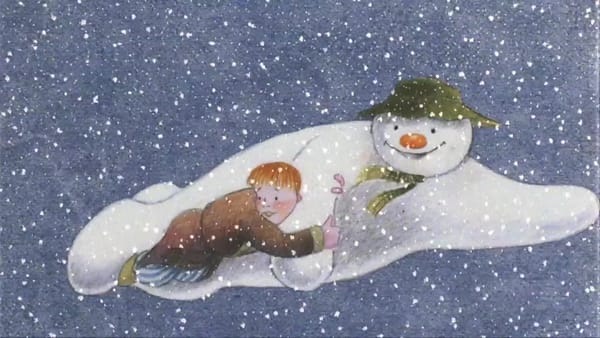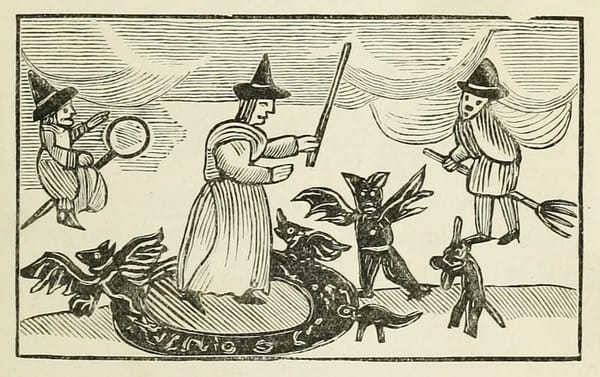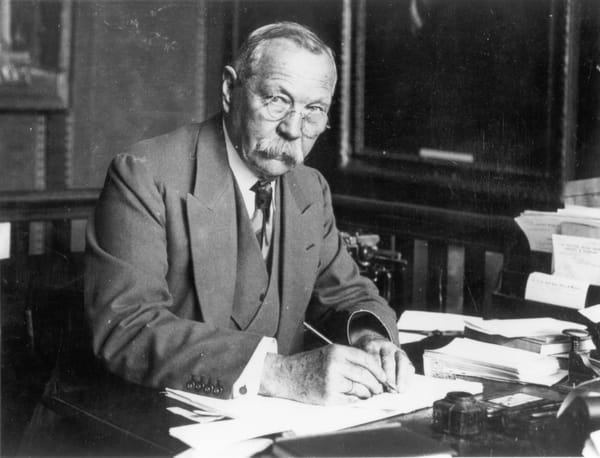Note 8: Folk horror
Modernity runs head first into the Old Gods.
October 2020 isn’t fooling around.
Since my last note (which seems like it was written last month), I’ve made a couple of major (temporary) lifestyle changes, had two new nephews arrive in less than a 24-hour window (and no, they are not twins), followed from afar as one new nephew had to be airlifted to the best hospital in New Mexico after some complications after birth (the issues have been resolved and he’s recovering nicely), broke into my own gated community (the touchscreen on the fancy new entryway system was non-responsive), and finally got my PC-VR Elite: Dangerous pilot to a place where we could go raid alien hatcheries. (Hail the LAZERCHICKEN!)
More local details below, so read until the end. In the meantime, let’s talk horror…
The Old Gods of the land are not to be trifled with.
This week’s Note will focus on folk horror. Since modern folk horror arises from more of a cinematic - as opposed to literary - soil, we have a lot of video to watch this week.
The term folk horror is a retroactive term, introduced in 2003 by Piers Haggard, and popularized by Adam Scovell in his 2017 review of British cinema and literature, Folk Horror: Hours Dreadful and Things Strange. The founding fathers of this flavor of horror consist of the Unholy Trinity of British films:
- Witchfinder General (1968): A disturbing tale of evil set during the English Civil War. When Matthew Hopkins (Vincent Price) is appointed Witchfinder General by the Puritans under Cromwell, he is empowered to travel the countryside with his henchmen and collect a fee for each witch from whom he extracts a confession - a policy which is exploited to the full. (Fandango)
- Blood on Satan’s Claw (1971): When a mysterious corpse is accidentally dug up by a boy in a small town, a group of local teens starts acting very strangely. The adolescents, led by a girl named Angel (Linda Hayden), are convinced the corpse was once possessed. Hoping to get in touch with the devil through the body, the teens act out a series of demonic rituals that causes a stir among the townspeople. When word of the satanic activity spreads, certain parents start trying to lock up the kids behind the spooky stunts. (Fandango)
- The Wicker Man (1973): Sergeant Howie (Edward Woodward) arrives on the small Scottish island of Summerisle to investigate the report of a missing child. A conservative Christian, the policeman observes the residents' frivolous sexual displays and strange pagan rituals, particularly the temptations of Willow (Britt Ekland), daughter of the island magistrate, Lord Summerisle (Christopher Lee). The more Sergeant Howie learns about the islanders' strange practices, the closer he gets to tracking down the missing child. (Rochester City Newspaper)
From the review of Scovell’s book:
This mass movement from agricultural to post-industrial life has detached us from the land that fed and clothed us for thousands of years, with the countryside becoming increasingly alien territory, avoided or misunderstood by those who have little contact with mud, dead animals, or the stench of excrement. Such urbanites have scant knowledge of farming or food production and patronise ancient local traditions. They are unnerved by the space, the silence. They fear their countryside, their own past.
Folk horror plays on such fears and explores the narratives lost during this migratory shift. Though its origins surely stretch back to the fireside telling of cautionary tales, the genre as we recognise it now was first named as recently as 2003, during an interview with Piers Haggard, the director of The Blood on Satan’s Claw (1971), and subsequently crystallised by Mark Gatiss in his 2010 BBC4 series A History of Horror.
While not a folk horror tale, Stephen King’s The Dark Tower, introduces a phrase thats useful in thinking about folk horror: the world has moved on:
“The world has moved on,” we say... we've always said. But it's moving on faster now. Something has happened to time.
Stephen King, The Gunslinger (1982)
In the gunslinger Roland Deschain’s world, moved on referred to the transition from one period of history to another. In that story, the world moved on when civilization collapsed and anarchy returned to Mid-World, setting the stage for the gunslinger’s journey.
In the context of folk horror, we can say that our world moved on when it transitioned from a largely rural and pastoral setting where people were more in-touch with their local surroundings, to an era where the connection between people, the areas they occupied, and their own family histories were severed through industrialization, widespread warfare and migration, and the importation of foreign religions (i.e. Christianity) that displaced the local home-grown deities and dogmas. The horror begins to manifest when a modern interloper discovers that the old religions and ways of life are not as dead and forgotten as they believed.
This is well-illustrated in the conversation between Sargent Howie and Lord Summerisle in The Wicker Man:
And the conflict isn’t always between the modern interloper and the pastoral villager
(or lord), it can also be internal, as illustrated by this exchange between a father and his adopted son in the BBC teleplay Penda’s Fen (1974):
These two examples highlight the religious conflict in the mind of residents of the British Isles, but folk horror isn’t exclusively British or focused on a religious transition.
While Ari Aster’s Midsommer (2019) has a definite religious aspect to it, the conflict at work is between modern expectations and Swedes celebrating an older way of living:
Peter Weir’s Picnic at Hanging Rock (1975) captures the same clash as a day trip for girls at a finishing school ends up illustrating the unforgiving nature of the Australian landscape and wilderness:
Robert Eggers’ The Witch (2015) highlights to what extent Nature (and a witch in the woods) refuse to tolerate trespassers on the colonial pre-independence American frontier:
While witches often figure heavily in the Western folk horror genre, Soviet filmmakers were creating witchy folk horror before the cinematic debut of the Unholy Trinity.
Konstantin Yershov and Georgi Kropachyov’s Viy (1963) was the first horror film to be released in the USSR:
Of all the folk horror I’ve seen, Norway’s The Troll Hunter (2010) may have been the first during a late-night movie binge. It was not what I expected at all:
Jude Law, Naomie Harris, and Katherine Waterstone became the most recent standard bearers for folks horror this year with The Third Day (2020):
This tale kicks off its first chapter Summer, a three episode arc where Law’s character - Sam - finds himself on Osea Island (a real place) and gets wrapped up in a pagan mystery there. The second half of the series, Winter, is another three-episode arc that follows Harris’ character - Helen - to the island as well. The television production (it aired on HBO and Sky) was exceptionally well done, but where the series really distinguished itself was in its intermission Autumn.
Autumn was originally intended to be a live event on the weekend between the airing of the Summer and Winter arcs where viewers could participate in a fall festival on Osea Island with the cast from the show. COVID nixed that plan, so instead, it ended up becoming a twelve-hour production that unfolded in real time on October 3rd. I don’t want to say too much about the event (it spoils some of the events in Summer), but you can see an abridged version online:
What was significant about the live event - other than killing a Saturday’s worth of productivity for me - was that it accomplished two main tasks that the dramatic episodes could not:
- It made viewers much more familiar with the island over a span of 12 hours. This transformed the work from a series of set-pieces into something that was situated in a real place. When Winter premiered, this heightened the verisimilitude of the entire endeavor.
- Its 12-hour running time helped establish the space between notable events during the course of the day. You had to watch things unfold on their own time, which is often lost in a cinematic context where the filmmaker only has a couple of hours of your attention. This allowed us to spend time with characters as they undergo dramatic transformations between their final appearance in Summer and subsequent appearance in Winter.
The Third Day set a high bar for folk horror and it’ll be interesting to see what comes next.
As mentioned in my disclaimer above, I’m still exploring the genre and I haven’t even gotten into the interesting work happening on the other side of the Pacific, which has its own traditions that dovetail nicely with the folk horror tradition.
Before the COVID pandemic, we were all living in an era of significant transition that’s found itself represented in our culture, politics, and modes of living. COVID accelerated that transition significantly, so it’ll be interesting to see in a few decades time whether the events we are living through today serve to make the world move on in the same way as the English Civil War, introduction of Christianity to Europe, or any of the other events on which good folk horror thrives. Given that the genre doesn’t function without an old world and a new world to play off each other, odds are good that our own time period will be featured prominently in this tradition.
Ask yourself, will you be playing the role of the villager? Or that of the interloper?
I’d be remiss to not wrap up this discussion with a musical bit, so here’s the best track from exceptional soundtrack of the The Wicker Man.
Other October 2020 Notes on Horror: Cosmic Horror, Liminal Horror.
Local updates
As mentioned in the introduction, this week’s been an eventful one for me. Family health drama has been the primary driver of events, but work’s kept me quite busy as well (I’m currently overseeing the recovery of a 2.8TB Postgres database in the EU.) I haven’t had a lot of time for too much, but I did manage to put in some quality VR time playing Elite: Dangerous this weekend.
If you’ll recall, something’s changed in the game or the network that has kept me from playing too much and taking the pictures as I had been doing in the summer. On the PC front, I found a workaround, which is to play through a virtual private network. This has worked out quite well and I’m starting to put in the time that I was putting into my Xbox pilot.
This weekend was spent upgrading my ship for further exploration (I’m flying a Diamondback Explorer on this account) and that journey took me to a Thargoid barnacle forest (not my video):
Between unlocking the alien content in VR and getting around to exploring the lost generation ships, I’m finally at a point where it’s very likely that I won’t return to the Xbox to play my original pilot. After all, who can argue with this spaceship cockpit?
The only downside to going exclusively VR is that capturing nice screenshots becomes an interesting problem that I don’t have a solution for yet. Maybe Frontier will have some news on this front for their Odyssey expansion scheduled for next year?
In other news (more stock-talk!), after I made my investments last week, I moved some money around when I learned that NASA will be paying Nokia to install a 4G network on the moon. I’ve owned Nokia shares in the past (and lost quite a bit when they failed to pull out of the dive that was killing their mobile phone business), but I’m feeling pretty good about this investment given that Nokia’s now in a very strong position in the infrastructure space (they and Ericsson are the only real alternatives to the Chinese mobile networking firms) and they should be in a decent position to expand on their positions when our mobile terminals go interplanetary.
Finally, given the increase in COVID infections that we’re seeing around the country and in Chicago, yesterday, I fetched everything I needed from the office to work from home for the next several weeks. My biggest concern was taking public transit as a vector for getting infected and passing the infection along, so I’ve eliminated that from my life until after the election. So, look forward to fewer pictures of big buildings and more images of dogs and home improvement until we get into the Christmas season proper.
Interesting reads
Voyager Spacecraft Detect an Increase in The Density of Space Outside The Solar System (Space Alert)
The VR revolution has been 5 minutes away for 8 years (Polygon)
Liberal Anxiety Over a 2016 Repeat May Be Why We Won't Have One (Jonah Goldberg)
o7, CMDRs!



